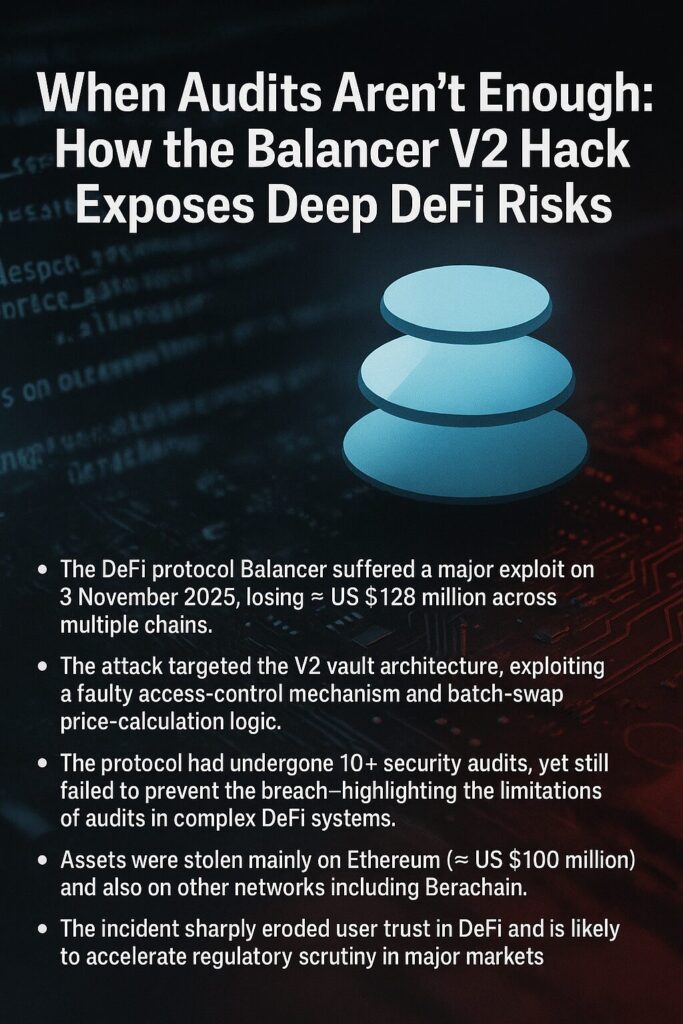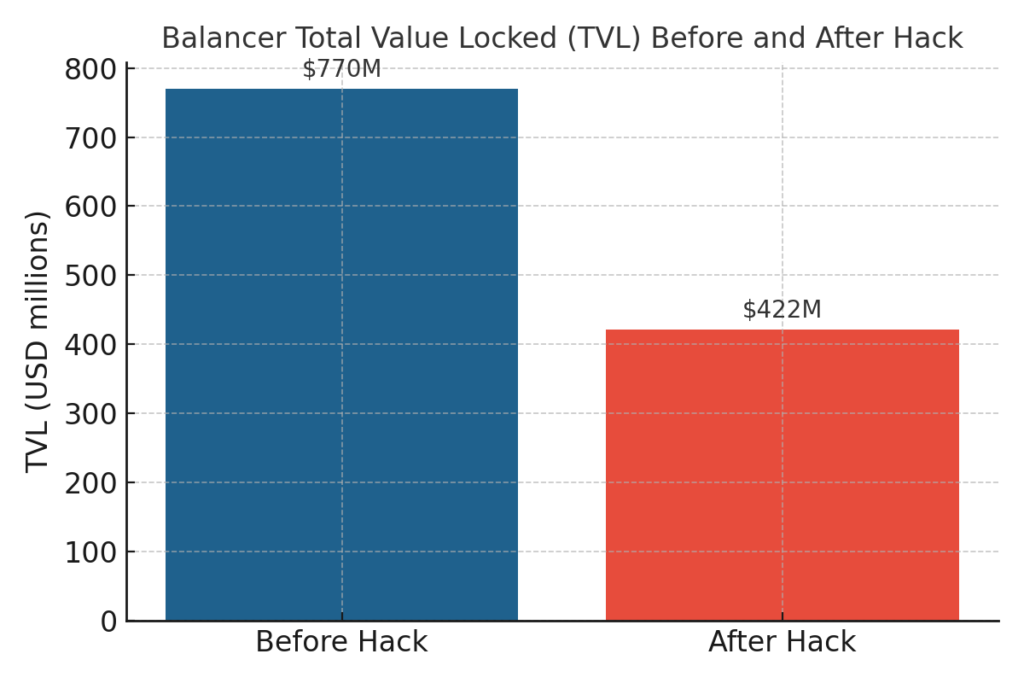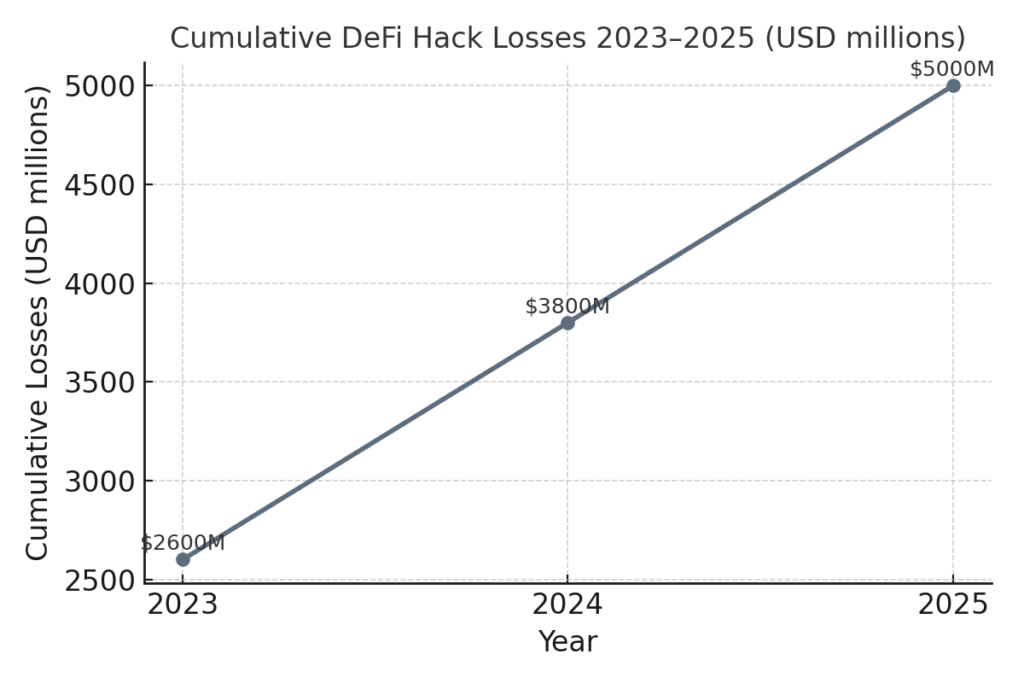
Key Takeaways :
- The DeFi protocol Balancer suffered a major exploit on 3 November 2025, losing ≈ US $128 million across multiple chains.
- The attack targeted the V2 vault architecture, exploiting a faulty access-control mechanism and batch-swap price-calculation logic.
- The protocol had undergone 10 + security audits, yet still failed to prevent the breach—highlighting the limitations of audits in complex DeFi systems.
- Assets were stolen mainly on Ethereum (≈ US $100 million) and also on other networks including Berachain.
- The incident sharply eroded user trust in DeFi and is likely to accelerate regulatory scrutiny in major markets.
1. Incident Overview

On 3 November 2025, Ethereum-based DeFi protocol Balancer announced that it had been exploited in its V2 pools. According to on-chain analytics, attackers drained over US $128 million (≈ €115 million) from Balancer and related deployments across multiple chains.
Specifically, data show that approximately US $100 million of the losses occurred on Ethereum, with the remainder spread across chains like Berachain (≈ US $12.9 million) and Arbitrum, Base, Polygon, Sonic, and Optimism.
Balancer responded by stating:
“We are aware of a potential exploit impacting Balancer v2 pools. Our engineering and security teams are investigating with high priority.”
In the immediate aftermath, the protocol paused any pools it could and initiated recovery mode procedures.
For stakeholders seeking new crypto assets or yield-opportunities, this event signals how even established high-profile DeFi ecosystems remain vulnerable, and that yield simply via platform participation may carry significant counterparty/contract risk.
2. Root-Cause and Attack Mechanics
2.1 Access-Control and Authorization Bypass
Security analyses highlight that the attacker exploited an authorization flaw in the „manageUserBalance“ or similar internal function in Balancer V2. The contract improperly compared msg.sender to a user-controllable parameter (op.sender), thus making it possible for an attacker to impersonate other users and withdraw internal balances.
2.2 Batch-Swap Price-Calculation Manipulation
Another key vector: the attacker manipulated the pool-price calculation logic in batch swaps. By injecting fake tokens, or crafting a malicious contract, the attacker distorted internal price feeds and then executed rapid withdrawals before the system equilibrated.
The protocol’s “composable vault” architecture — wherein multiple internal pools interconnect and reference each other — amplified the damage because the distortion in one pool rapidly propagated.
2.3 Implications for Yield Hunters
For an investor or liquidity-provider in DeFi, this means that visible factors (brand reputation, audit history, TVL) may not fully capture systemic risk. Technically sound code may still harbour subtle holes, especially when multi-chain, multi-pool, and cross-protocol composability is involved. That complexity can increase the surface for attackers.
When evaluating future yield opportunities, it is not sufficient to rely simply on audit badges or past longevity; deeper questions need to be asked about architecture, complexity, chain-scope, inter-protocol dependencies, access-control rigor, and ex-post response capabilities.
3. Audit History vs Reality
The irony in this case is stark: Balancer V2 had undergone 10 or more security audits by firms such as Trail of Bits, OpenZeppelin, Certora and others.
Yet, despite that multiple layer of review, authentication logic, batch-swap logic, vault composition vulnerabilities were not caught. This draws attention to several structural issues:
- Audits are point-in-time snapshots, whereas DeFi protocols evolve rapidly (versions, forks, integrations).
- Complex architectures (multi-token pools, composable vaults) increase attack surface exponentially.
- Audits may not always replicate real-world exploit scenarios (flash loans, MEV, cross-chain interactions, callback logic).
- Longevity and brand do not equate to immunity. As one commentator put it, “a protocol live since 2020, audited and widely used, can still suffer a near-total TVL loss.”
3.1 For Investors: Lessons
- Treat audits as one dimension of risk assessment, not a guarantee of safety.
- Be aware of high-complexity pools (multi-token, weighted, composable) which may carry hidden risk.
- Diversify across protocols, chains and ensure your own exposure is limited in any one system.
- Monitor TVL, but also monitor red flags: unusual token approvals, new pool versions, rapid changes.
- Consider yield opportunities with simpler risk-curves (e.g., protocols with minimal composability, single-token pools, audited and open-source architecture).
4. Impacts on DeFi Ecosystem & Emerging Trends
4.1 Trust Erosion and Flight of Capital
This exploit uproots one of DeFi’s long-standing narratives: that mature, audited protocols equal safety. When a veteran protocol like Balancer is breached, user confidence is shaken. According to on-chain data, Balancer’s TVL dropped by ~46% to around US $422 million from ~US $770 million by end of day 3-Nov.
For yield-seekers and liquidity-providers, this means increased vigilance is needed. A major protocol’s failure can trigger cascade effects (withdrawals, panic, contagion) that may reduce yield across adjacent systems.

4.2 Regulatory & Institutional Response
Regulators globally (US, Europe, Japan) are increasingly focusing on DeFi counterparty risk, systemic risk, and platform-governance issues. As Chainalysis’ CEO Jonathan Levin stated:
“The rapid growth of DeFi platforms, which operate with little traditional security oversight, has left users’ assets at risk.”
This exploit amplifies regulatory urgency: institutional investors may pull back from DeFi exposure, expecting stronger governance, audited internal controls, and standardized risk frameworks.
4.3 Emerging Trends in Response
- Simplification over complexity: Some new DeFi protocols are favouring simpler architectures (fewer tokens per pool, single-asset staking) to reduce attack surface.
- Cross-chain security standards: With exploits spanning Ethereum, Berachain, Arbitrum etc., new tools for multi-chain risk mapping are gaining traction.
- Composability insurance / protocol insurance products: Given that dependencies between protocols can amplify loss, on-chain insurance mechanisms and coverage for smart-contract failure are becoming more mainstream.
- Active revocation & liquidity exit tools: Investors increasingly expect protocols to provide quick exit tools and revocation of approvals (e.g., via Revoke .cash) as part of standard user-flows.
5. Practical Implications for Seeking New Crypto Assets and Yields
For readers seeking new assets or next-level yield opportunities, this event serves as both a warning and a guide:
- When engaging with a new DeFi protocol, ask: What is the complexity of the architecture? Are there multi-token weighted pools? How many integrations/forks/versions exist?
- Check history of audits and track record of exploit incidents. A clean history is helpful, but not sufficient.
- Evaluate cross-chain exposures: Does protocol operate on multiple chains? Are the vaults composable across chains? More exposure can mean more risk.
- Look for systems with transparent governance, open-source code, active audits underway, and an empowered community able to propose emergency responses.
- From risk-management perspective: never allocate more capital than you’re prepared to lose in a worst-case failure. DeFi yield is not risk-free.
- Consider that post-event, the yield premiums may rise (i.e., higher yields may be offered to attract capital). But higher yield often signals higher risk.
- Monitor the broader market: This hack may trigger capital flight from high-TVL DeFi to newer, leaner protocols or even to non-DeFi crypto (e.g., NFTs, tokenised real-world assets, gaming/metaverse).
6. Conclusion

The Balancer exploit stands as a stark reminder: in the fast-moving world of DeFi, audits and longevity are not bulletproof guarantees of safety. For the asset-seeking investor, the aim must shift from simply chasing yield to understanding structural risk—how protocols are built, how they update, how they respond in crisis, and how interlinked they are within the broader ecosystem.
While the opportunistic investor may still find attractive yield and token opportunities, the margin for error has shrunk. As regulation tightens and institutional capital eyeing DeFi grows more cautious, the platforms that will thrive are those built with simplicity, transparency, composability managed, and security-first governance. In the meantime, each participant in this ecosystem must treat capital deployed into DeFi not simply as yield-seeking, but as risk-managed deployment.

